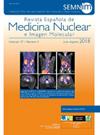预测非转移性三阴性乳腺癌生存率的新异质性方法
IF 1.6
4区 医学
Q3 RADIOLOGY, NUCLEAR MEDICINE & MEDICAL IMAGING
Revista Espanola De Medicina Nuclear E Imagen Molecular
Pub Date : 2025-06-24
DOI:10.1016/j.remn.2025.500112
引用次数: 0
摘要
目的探讨非转移性三阴性乳腺癌(TNBC)患者18f -氟脱氧葡萄糖正电子发射断层扫描/计算机断层扫描(18F-FDG PET/CT)成像及生存数据的半定量正电子发射断层扫描(PET)参数与瘤内异质性(ITH)的关系。方法连续纳入62例接受18F-FDG PET/CT预处理的非转移性TNBC女性患者。评估来自肿瘤代谢体积(MTV)和原发病变标准化摄取值(SUV)参数的异质性指数(HI)变量。提出了一种新的改进方法,引入基于百分比(30-40-50%)的MTV坡度比较。回顾性分析常规18F-FDG PET/CT参数、HI值与生存结果之间的关系。结果患者HI值越高,生存时间越短。总生存期(OS)方面,HI2、HI3差异有统计学意义(P= 0.009、P= 0.016)。放射学无进展生存期(rPFS)方面,HI1和HI3差异有统计学意义(P= 0.01, P= 0.025)。HI1与肿瘤大小呈显著的弱相关(P= 0.005, rho= 0.34), HI2与肿瘤大小呈显著的强相关(P= 0.0001, rho= 0.89), HI3与肿瘤大小的相关性无统计学意义(P= 0.063, rho= 0.23)。T分期与rPFS、OS相关,差异有统计学意义(P= 0.038, P= 0.003)。相比之下,N分期、解剖分期和临床分期无统计学差异(P> 0.05)。结论:ITH可预测非转移性TNBC患者的生存。这一结论是通过不同方法获得的异质性指标变量得出的。然而,我们的结果显示HI2取决于肿瘤的大小。我们改进的方法(HI3)独立于肿瘤大小预测生存。本文章由计算机程序翻译,如有差异,请以英文原文为准。
Nuevo método de heterogeneidad para predecir la supervivencia en el cáncer de mama triple negativo no metastásico
Objective
This study aimed to investigate the relationship between semiquantitative positron emission tomography (PET) parameters and intratumoral heterogeneity (ITH) on 18F-fluorodeoxyglucose positron emission tomography/computed tomography (18F-FDG PET/CT) imaging and survival data of non-metastatic triple-negative breast cancer (TNBC) patients.
Methods
Sixty-two consecutive female patients who underwent pretreatment 18F-FDG PET/CT with non-metastatic TNBC were enrolled. Heterogeneity index (HI) variables derived from the metabolic tumor volume (MTV) and standardized uptake value (SUV) parameters of primary lesions were evaluated. A novel modified method introducing a percentage-based (30-40-50%) MTV slope comparison was proposed. The association between conventional 18F-FDG PET/CT parameters, HI values, and survival results was analyzed retrospectively.
Results
Tumors with higher HI values were associated with shorter survival times. For overall survival (OS), HI2 and HI3 were statistically significant (P=.009, P=.016). Regarding radiological progression-free survival (rPFS), HI1 and HI3 were statistically significant (P=.01, P=.025). A significant weak correlation between HI1 (P=.005, rho=.34) and a strong correlation was found for HI2 (P<.0001, rho=.89), HI3 and tumor size were not statistically significantly correlated (P=.063, rho=.23). T stage was statistically significantly associated with rPFS and OS (P=.038, P=.003). In contrast, no statistically significant difference was found for the N stage, anatomical, and clinical staging (P>.05).
Conclusion
This study concluded that ITH predicts survival for non-metastatic TNBC patients. This conclusion was reached with the heterogeneity index variables obtained by different methods. However, our results revealed that HI2 depends on tumor size. Our modified method (HI3) predicts survival independently of tumor size.
求助全文
通过发布文献求助,成功后即可免费获取论文全文。
去求助
来源期刊

Revista Espanola De Medicina Nuclear E Imagen Molecular
RADIOLOGY, NUCLEAR MEDICINE & MEDICAL IMAGING-
CiteScore
1.10
自引率
16.70%
发文量
85
审稿时长
24 days
期刊介绍:
The Revista Española de Medicina Nuclear e Imagen Molecular (Spanish Journal of Nuclear Medicine and Molecular Imaging), was founded in 1982, and is the official journal of the Spanish Society of Nuclear Medicine and Molecular Imaging, which has more than 700 members.
The Journal, which publishes 6 regular issues per year, has the promotion of research and continuing education in all fields of Nuclear Medicine as its main aim. For this, its principal sections are Originals, Clinical Notes, Images of Interest, and Special Collaboration articles.
 求助内容:
求助内容: 应助结果提醒方式:
应助结果提醒方式:


